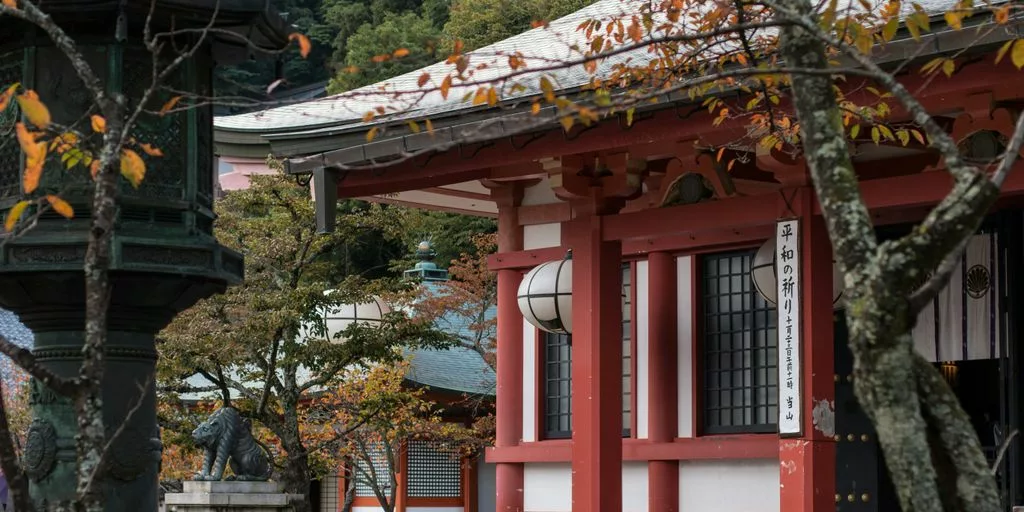
The Timeless Beauty of Kyoto’s Temples
Kyoto’s spiritual landscape is adorned with over 1,600 temples and shrines, each offering a unique glimpse into Japan’s rich cultural history. These sacred sites are not just places of worship but also architectural marvels that have stood the test of time.
Kinkaku-ji: The Golden Pavilion
Kinkaku-ji, also known as the Golden Pavilion, is one of Kyoto’s most iconic landmarks. The top tiers of this stunning temple are adorned in gold leaf, shimmering in the reflecting waters of the adjacent pond. It’s a sight that leaves visitors in awe.
Ryoan-ji: The Zen Rock Garden
Ryoan-ji is famous for its Zen rock garden, a masterpiece of minimalism and tranquility. The garden features carefully arranged rocks and white gravel, inviting visitors to meditate and find inner peace.
Kiyomizu-dera: The Pure Water Temple
Kiyomizu-dera, or the Pure Water Temple, offers breathtaking views of Kyoto from its wooden terrace. This temple is a must-visit for anyone exploring Kyoto’s historic sites. Its name comes from the Otowa Waterfall, whose waters are believed to have wish-granting powers.
Experiencing Traditional Kyoto Cuisine
Kyoto’s culinary heritage is a feast for the senses, offering a delightful journey through food and culture. The city’s traditional cuisine is celebrated for its seasonal and local ingredients, as well as its delicate presentation and flavors.
Kyoto’s Seasonal Festivals and Celebrations
Kyoto is a city that comes alive with vibrant festivals throughout the year. These celebrations are a testament to the city’s rich cultural heritage and offer a unique glimpse into its traditions and customs. From grand parades to serene rituals, there’s something for everyone to enjoy.
Gion Matsuri: Kyoto’s Grand Festival
Held every July, Gion Matsuri is Kyoto’s most famous festival. The highlight is the grand procession of traditional floats, known as "yamaboko," which are beautifully decorated and paraded through the streets. The festival also features various events, including traditional music and dance performances, making it a must-see for anyone visiting Kyoto.
Aoi Matsuri: The Hollyhock Festival
Taking place in May, Aoi Matsuri is one of Kyoto’s oldest festivals. Participants dress in Heian-era costumes and parade from the Imperial Palace to the Kamo Shrines. The festival is named after the hollyhock leaves that are used to decorate the costumes and floats, symbolizing protection from natural disasters.
Jidai Matsuri: The Festival of Ages
Celebrated in October, Jidai Matsuri is a historic parade that showcases Kyoto’s millennium-long history. Participants dress in costumes representing various periods, from the Heian era to the Meiji Restoration. The parade starts at the Imperial Palace and ends at Heian Shrine, offering a fascinating journey through time.
Experiencing these festivals is like stepping into a living history book, where the past and present blend seamlessly. Don’t miss the chance to immerse yourself in Kyoto’s cultural tapestry through these vibrant celebrations.
Artisan Crafts and Traditional Workshops
Kyoto is a treasure trove of traditional crafts that have been passed down through generations. From the intricate weaving of kimonos to the delicate art of pottery, the city offers a glimpse into Japan’s rich cultural heritage.
Exploring Kyoto’s Historic Districts

Step into Gion, Kyoto’s most famous geisha district, where the charm of old-world Japan comes alive. Wander through narrow streets lined with traditional wooden machiya houses and discover hidden teahouses where geishas entertain. The district is a cultural gem, offering a glimpse into Japan’s rich heritage.
Arashiyama is a must-visit for nature lovers. Stroll through the enchanting bamboo groves and visit ancient temples that dot the landscape. The area is perfect for a leisurely walk, offering picturesque scenery at every turn. Don’t miss the iconic Togetsukyo Bridge, a symbol of Arashiyama’s timeless beauty.
Higashiyama is a treasure trove of history and culture. As you wander through its preserved streets, you’ll find traditional shops selling Kyoto’s famed crafts and sweets. The district is home to Yasaka Pagoda, the last remnant of Hokan-ji Temple, standing tall amidst the old-world ambiance. A visit to Higashiyama isn’t complete without trying yatsuhashi, a cinnamon-flavored delicacy that’s a local favorite.
The Spiritual Side of Kyoto
Fushimi Inari Shrine: The Path of a Thousand Torii
Discover the mesmerizing path of a thousand torii gates at Fushimi Inari Shrine. This iconic site is dedicated to Inari, the Shinto god of rice. As you walk through the vibrant red gates, you’ll feel a deep connection to Japan’s spiritual roots. The hike up Mount Inari offers breathtaking views and a serene escape from the bustling city.
To-ji Temple: The Five-Story Pagoda
To-ji Temple, with its towering five-story pagoda, stands as a testament to Kyoto’s rich history. Founded in the early Heian period, this temple is a UNESCO World Heritage site. The pagoda, the tallest wooden structure in Japan, is a marvel of ancient architecture. Don’t miss the monthly flea market, where you can find unique antiques and local crafts.
Yasaka Shrine: The Heart of Gion
Located in the historic Gion district, Yasaka Shrine is a vibrant hub of cultural activity. This shrine is famous for hosting the annual Gion Matsuri, one of Japan’s most famous festivals. The shrine’s lush gardens and traditional structures offer a peaceful retreat. Whether you’re visiting during a festival or on a quiet day, Yasaka Shrine provides a glimpse into Kyoto’s spiritual and cultural heritage.
Delve into Kyoto’s spiritual side in peaceful Uji city. From Byodo-in Temple to Ujigami Shrine, escape the crowds and immerse yourself in history.
Gardens and Nature in Kyoto
Philosopher’s Path: A Scenic Walk
Stroll along the Philosopher’s Path, a stone walkway that follows a canal lined with cherry trees. This serene path is especially beautiful during cherry blossom season, offering a peaceful retreat from the city’s hustle and bustle. Along the way, you’ll find quaint cafes and small temples, perfect for a quiet moment of reflection.
Arashiyama Bamboo Grove: A Natural Wonder
Step into the enchanting Arashiyama Bamboo Grove, where towering bamboo stalks create a mesmerizing, otherworldly atmosphere. The grove is a must-visit for nature lovers and photographers alike. As you wander through the bamboo forest, you’ll feel a sense of calm and wonder, making it a perfect escape from urban life.
Kyoto Botanical Gardens: A Floral Paradise
Discover the beauty of the Kyoto Botanical Gardens, the oldest and most comprehensive public botanical garden in Japan. This ever-changing garden can be enjoyed all year round with its seasonal blooms and diverse plant collections. Whether you’re a botany enthusiast or simply looking for a peaceful place to relax, the Kyoto Botanical Gardens is a delightful place to visit.
Conclusion
Kyoto is a city where history and culture come alive. From its serene temples and beautiful gardens to its traditional arts and delicious food, Kyoto offers a unique glimpse into Japan’s rich heritage. Whether you’re walking through its ancient streets or taking part in a tea ceremony, every moment in Kyoto is a step back in time. This city invites you to slow down, appreciate the details, and truly experience the beauty of its traditions. So, if you’re looking for a place that blends the old with the new, Kyoto is the perfect destination.
Frequently Asked Questions
What are some must-see temples in Kyoto?
Some must-see temples in Kyoto include Kinkaku-ji, also known as the Golden Pavilion, Ryoan-ji with its famous Zen rock garden, and Kiyomizu-dera, the Pure Water Temple.
What traditional foods should I try in Kyoto?
When in Kyoto, you should try Kaiseki, which is Japanese fine dining, visit Nishiki Market for a variety of local foods, and enjoy Matcha tea, which is a big part of Kyoto’s tea culture.
What are some famous festivals in Kyoto?
Kyoto is known for its vibrant festivals such as Gion Matsuri, the city’s grand festival, Aoi Matsuri, also known as the Hollyhock Festival, and Jidai Matsuri, the Festival of Ages.
Where can I learn about traditional crafts in Kyoto?
You can learn about traditional crafts at places like the Nishijin Textile Center for kimono weaving, Kiyomizu-yaki for pottery and ceramics, and various calligraphy workshops around the city.
What are the best historic districts to visit in Kyoto?
Some of the best historic districts in Kyoto to visit are Gion, known for its Geisha culture, Arashiyama, famous for its bamboo groves and temples, and Higashiyama, which has well-preserved streets and shops.
What are some scenic nature spots in Kyoto?
For scenic nature spots, you can visit the Philosopher’s Path for a beautiful walk, the Arashiyama Bamboo Grove for a unique natural experience, and the Kyoto Botanical Gardens for a variety of floral displays.






